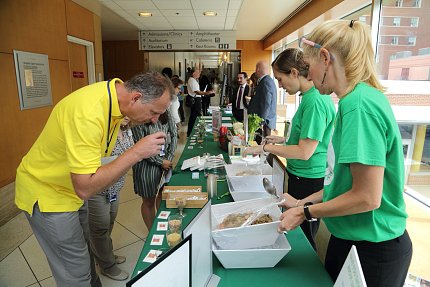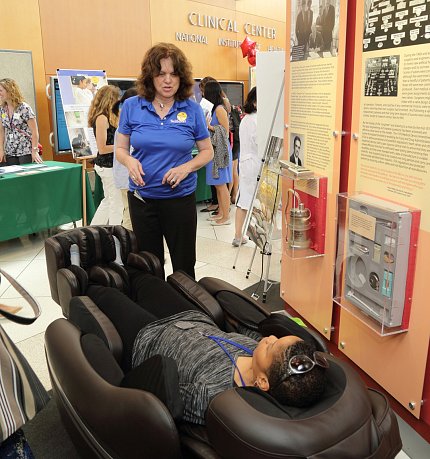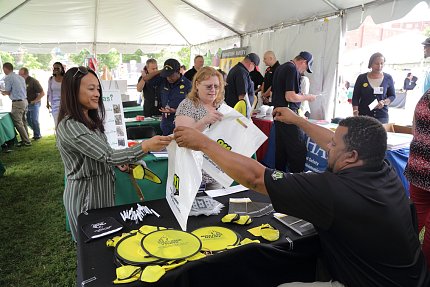Expo Promotes Safer, Healthier Living

Photo: Ernie Branson
Are you sitting ergonomically at your desk? Know the difference between heat exhaustion and heat stroke? Thinking about ways to get in better shape? NIH’ers got answers to these questions among the many other helpful tips and fun activities they enjoyed at the 5th annual Safety, Health & Wellness Day held recently.
The expo, held in previous years in Natcher Bldg. in August, featured info tents outside the Clinical Center’s south entrance, food trucks and farmer’s market vendors, more health-related exhibits just inside and fitness classes in the FAES classrooms. ORS and co-sponsors moved the location and date to increase visibility and participation.
“This was an opportunity for employees to see, know and understand services that are here for them to support their overall health, safety and well-being,” said Chris Gaines, program manager for NIH fitness and wellness services. “There are so many great services here and, in many cases, they’re free of charge.”

Photo: Ernie Branson
Some stopped by for a free chair massage, provided by local massage therapists. Some came for health and fitness screenings or to try out a free fitness class, from Zumba to yoga to piloxing (a combination of Pilates, boxing and dance), led by NIH Fitness Center instructors.
“Remember, your first gym session is free so try out classes or the machines and see what you like before you join,” said Gaines.
Those who stopped by exhibit tables learned ways to stay safe at work and at home. ORS’s Division of Occupational Health and Safety (DOHS) offered information on environmental, chemical, electrical and fire safety. For instance, did you know you’re supposed to replace all smoke alarms when they’re 10 years old? A new Maryland law also requires replacing any battery-only smoke alarms with ones powered by sealed-in, 10-year, long-life batteries.
Concerned about air quality in your office? If you smell a potentially toxic chemical, you’d call the campus fire department. But for general occupational health and safety concerns, each IC has an assigned specialist, who can be found through DOHS’s Safety Operations and Support Branch. NIH safety specialists showed off gadgets they use to check humidity, temperature and air quality.

Photo: Ernie Branson
At one DOHS table, many recoiled at the sight of a vial of bedbugs, and were surprised to learn their actual size is just 3/16th of an inch. NIH’s Integrated Pest Management staff explained how to spot these miniscule critters and prevent them from becoming your traveling companions. Also offering warnings about insects was NIAID, distributing information about ways to protect against mosquito bites and Zika virus.
Addressing personal safety, campus police emphasized awareness and common sense.
“Know your neighbors, at work and at home,” advised Cpl. John Coe, “and be aware of people in your immediate surroundings. If someone comes along who nobody recognizes, who looks out of place, call the police. Don’t get involved in the situation. Don’t chase or confront anybody. Get a good description of the suspicious person and police will respond.”
Coe also offered a common sense summertime tip: “In hot weather, some people [wanting to keep the air conditioning going] leave their car running while they run into the store,” he said. “First of all, that’s illegal in Maryland. And second, if your car gets stolen, insurance won’t replace it. It’s the little things; have street sense.”

Photo: Ernie Branson
The National Weather Service disseminated information about staying safe in severe weather and riptides and how to detect heat stroke.
Both heat exhaustion and heat stroke can cause nausea, but heat stroke does not cause sweating; rather, the person may have a throbbing headache, a rapid and strong pulse, red, hot skin and may lose consciousness. If you suspect someone has heat stroke, call 911 and take immediate action to cool the person until help arrives.
And about improving ergonomics at your desk? DOHS’s Occupational Medical Service says monitors should be placed no more than an arm’s length in front of you and suggests putting a support, such as a rolled-up towel, behind your lower back to prevent slouching.
To learn more about NIH’s many resources for employees, visit the Amenities and Health & Safety tabs at www.ors.od.nih.gov.
